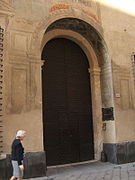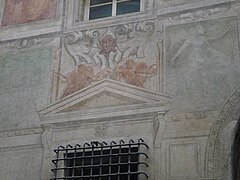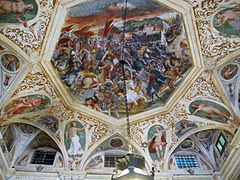Palazzo Angelo Giovanni Spinola
| Palazzo Angelo Giovanni Spinola | |
|---|---|
 Façade of Palazzo Angelo Giovanni Spinola | |
 | |
| Alternative names | Palazzo Doria |
| General information | |
| Status | Intact |
| Type | Palace |
| Architectural style | Mannerist |
| Location | Genoa, Italy |
| Address | 5, Via Garibaldi |
| Coordinates | 44°24′39.6″N 8°56′1.3″E / 44.411000°N 8.933694°E |
| Current tenants | Deutsche Bank |
| Named for | Angelo Giovanni Spinola |
| Construction started | 1558 |
| Completed | 1576 |
| Renovated | 1580 |
| Design and construction | |
| Architect(s) | Giovanni Ponzello |
The Palazzo Angelo Giovanni Spinola, also known as Palazzo Doria, is a palace in Via Garibaldi, Genoa, Italy. It is one of the 42 Palazzi dei Rolli listed by UNESCO as World Heritage Sites.
History
Construction of the palace began in 1558 by Angelo Giovanni Spinola, Ambassador of the Republic of Genoa to Spain and banker to Emperor Charles V. It was completed in 1576 by his son Giulio, and in 1580 he excavated part of the hill behind the palace in order to expand the rear part of the building, including the courtyard and garden. The building was designed by the architect Giovanni Ponzello.
In 1919, the palace was sold to the bank Crédit Commercial de France, and it was converted into offices. In 1926, it was given to the Banca d'America e d'Italia, and it now belongs to Deutsche Bank.
The façade of the palace is decorated by a number of frescoes by the Calvi brothers, who might have worked with Lazzaro Tavarone. The frescoes depict members of the House of Spinola dressed as Roman condottieri. A staircase decorated by grotesque frescoes leads to the upper floor, which contains further frescoes by Andrea Semino, Bernardo Castello and Lazzaro Tavarone. A fresco attributed to Semino shows the building in its original state, as viewed from a mountain.[1]
Gallery
-
Door
-
Detail of the frescoes on the façade
-
Frescoes in the atrium
-
Frescoes on the ceiling of the atrium
References
- ^ "Via Garibaldi 5 - Angelo Giovanni Spinola". irolli.it. Archived from the original on 4 June 2013.




